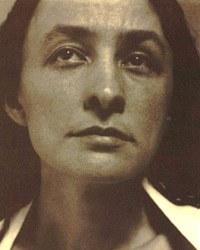Georgia O’Keeffe
American artist (1887 - 1986)

- || At The Bottom
1909 -- Georgia O'Keeffe hadn't attended art school in New York and Chicago so that she could spend her days drawing lace embroidery for magazine advertisements and being paid by the piece. Since the age of 12 she had dreamed of being an important artist, and her talent was visible to her teachers, who recognized her with several small awards and scholarships during her art school years. But by 1908, her family's increasingly difficult financial situation spurred O'Keeffe to find work -- any kind of work -- that would allow her to make a living on her own. As a freelance illustrator, O'Keeffe fulfilled that minimal goal. The work was dull, though, and she hated every minute of it. By the end of each day, she was too exhausted to work on her own art -- the smell of paint and turpentine only frustrated her further, a reminder of the artistic drive that she'd once possessed but had somehow lost by her early 20's. She continued as a freelancer for a year before contracting a severe case of measles that actually harmed her eyesight badly enough that she could no longer continue. She moved back to her family's home in Virginia, where her father struggled to keep his farm and small business alive and her mother endured the early stages of tuberculosis. Before long she wrote a letter to a friend, telling him that she was giving up painting for good.
- || At The Top
1928 -- Georgia O'Keefe's annual show at the Room -- a New York gallery founded by the photographer Alfred Stieglitz -- was a stunning and historic success. In the midst of a general decline in the art market that year, O'Keeffe sold six small paintings of calla lilies for the price of $25,000, an amount that represented the largest amount ever paid for a work of art by a living American artist. Her work was not simply financially rewarding, however. The famous art critic Henry McBride heaped praise on O'Keeffe's work in the pages of the New York Sun, describing the "simple, smooth surfaces" in her work that "change so slowly in tone that it sometimes appears as though a whole earth would be required to make them go all the way around." O'Keeffe would enjoy the same combination of critical and financial success for the next six decades, as she evolved into one of the most important American painters of the 20th century.
- || The Comeback
Georgia O'Keeffe didn't touch a paintbrush for two years, but in early 1911 a family friend -- an art teacher at a private high school -- asked her to teach some art classes there. She agreed and quickly discovered that she was a talented teacher. Moreover, the process of teaching others to paint reminded her of her own youthful enthusiasm for art, and she began to consider the possibility that she might be able to make a career out of it after all. She imagined herself living in the Virginia countryside, teaching and painting and enjoying a quiet life, but when she took a summer class at the University of Virginia in 1912, she so impressed her professor that he insisted she continue taking his courses. Within a few years, she had been hired as his teaching assistant, a job that soon led to her appointment as an instructor at West Texas A&M. Her professor at Virginia also passed along some of her work to Alfred Stieglitz, a renowned photographer and one of New York's most important art promoters during the early 20th century. In 1916, Stieglitz exhibited some of O'Keeffe's work at his gallery; the next year, he offered O'Keeffe the opportunity for a solo show. Following these initial successes, O'Keeffe moved to New York and began her rise within the American art world. (As an added bonus, she and Stieglitz fell in love and were married in 1924.)



